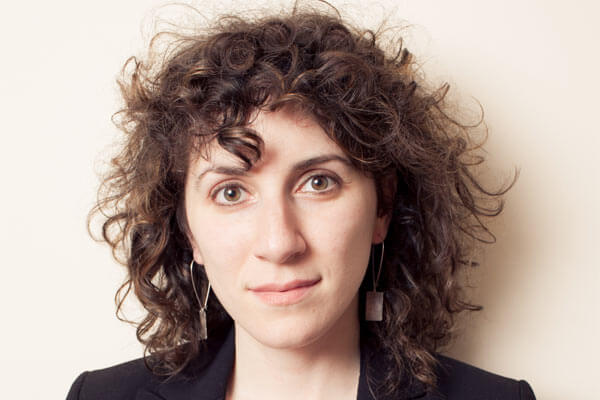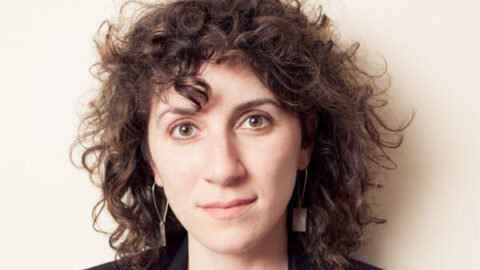Composer—and community builder—Lainie Fefferman will be presenting “Here I Am” at Roulette on Thursday, May 1, 2014 @ 8:00 pm. We had a quick chat about this ambitious piece and what it meant for her…
What inspired you to set these portions of the Hebrew Bible to music?
I got more and more obsessed with Torah stories while I was in college. My family gave me a strong Jewish identity, but that identity was largely created by wonderful things like klezmer music and Woody Allen, pastrami on rye and Isaac Stern. We’d light candles for Hannukah and maybe go to temple for high holidays, but when I got to college I fell comfortably under the label of “Secular Jew.” I decided to take Hebrew my freshman year, not thinking too deeply about why, and that ended up bringing me to a fascination with the religious documents on which my “secular” identity was based. The language of the Torah is surprisingly plain – enough so that a dedicated Hebrew student can start understanding a nice amount of it pretty quickly. (The “thee”s and “thou”s and “thine”s of the King James Bible are no where to be found in the Hebrew – its spare, strong language was part of what drew me in.) I found a lot of stories that showed me where the argumentative, feisty Jewish culture I loved was born, and found some stories that felt completely foreign to the identity with which I’d been raised. You’ll hear both kinds of stories coming at you on Thursday! I’m a composer, so I guess when I get obsessed with any idea for any reason, it all comes out in the music. This piece is a weird little window to what’s been poking Lainie’s brain for the last bunch of years.

I believe that this large, ambitious piece took you five years to complete (it is your PhD thesis at Princeton, right?)—quite a chunk of time in the life of a young composer. Besides the compositional feat, you basically spent 5 years working on scripture (not unlike a large scale meditation) and I’m curious about how this influenced your spirituality…
Man, this is a rough one! Actually, just now, really thinking about your question, I’m realizing that my way of grappling with these stories has been by trying to put myself in the place of each of the people in them, not by thinking about questions of divine character or omniscience or perfection. What would I think and feel and do if I were Moses coming down off the mountain to find a gang of raging Israelites? Is there any scenario I can craft where I would have acted as Abraham did when asked to sacrifice his son? Would I have had the courage to argue and bargain with omnipotence to save my fellow man? …could I really have been convinced that men with crushed testes should be expelled from my society? I think it’s actually in keeping with Jewish tradition that the way I explore my spirituality is by exploring my relationship with humanity. Apparently overblown clarinet squeals and sul pont cello tremolos are the ways I’ve chosen to undertake that exploration over the last 5 years.
And yes, this is my PhD thesis for Princeton! I don’t technically *have* the PhD yet, so let’s hope my profs end up liking what they hear on Thursday…
Stylistically, Here I Am borrows from a variety of genres: rock, minimalism, folk, etc. Were you serving the text, or did you try to illustrate your musical influences? These are not necessarily mutually exclusive…
I was completely intuitive with my musical choices. I listen to all kinds of music and use different techniques and styles routinely in all of my pieces, the way a lot of us are doing nowadays. For Here I Am, I didn’t have any kind of premeditated scheme like “angry words get rock treatment” or “lists get minimalism,” but I bet if you look for patterns like that you’ll probably find them. I really did just let myself do whatever I felt like doing with each passage, not requiring any justification or logic from my own mind. My brother pointed out that I often used the sweetest music for the most difficult texts – I think that’s true. I am so amazingly lucky to be working with soprano Mellissa Hughes, who can convey a huge emotional range in her singing, and can flip in and out of radically different vocal styles at the drop of a hat. I can’t imagine anyone else doing what she does for this piece!
Can you tell me more about the lighting design?
Gosh, I wish I could – I haven’t seen it yet! Ashley Kelly Tata, Here I Am‘s director, brought Anshuman Bhatia in on the project, and from chatting with him I know the lighting is going to be amazing…but I don’t get to see it till dress rehearsal on the day of the show – so it goes in the rushed life of New Music productions! I can tell you that strong theatrical lighting was really important to me for this work from the beginning of its inception. I don’t think of Here I Am as a traditional concert piece, I think of it as a theatrical piece. Lighting is a beautiful way to get audience brains into a theatrical place.

You wrote Here I Am for Newspeak and Va Vocals (Martha Cluver, Mellissa Hughes, and Caroline Shaw). Did you actually write with individual performers in mind or were you inspired by their signature “sound”?
Boy oh boy did I write with the individual performers in mind! I know most of these folks pretty well, and I am a huge believer in writing idiosyncratically for great players whenever possible. There are dozens of examples of that in this piece: Taylor Levine, master-craftsman of guitar pedals and pedaling, has a giant noise solo that I essentially notated as “Taylor, do that thing you do so well!” Caleb Burhans is technically Newspeak’s violin, but I know about his fabulous voice, so the part became not for violin, but for singing fiddler. Newspeak offers a fabulous toolbox for a composer to tinker with! And then the trio of sopranos, Va Vocals – there I really capitalized on their individual tones and talents. I notice that a lot of composers ask singers to blend their voices into one homogenous sound, the way you might think of writing for a string quartet, but I really love writing for vocalists the way you’d write for a wind quintet or a Pierrot ensemble – celebrating the different timbres and personalities of their voices to create shape and contrast in the music. These ladies do a remarkable job creating a cohesive, powerful sound while keeping their strong singer-identities intact. In this piece, it all comes back to exploring identity!
For more information and tickets, visit: http://roulette.org/events/lainie-fefferman-here-i-am/
























